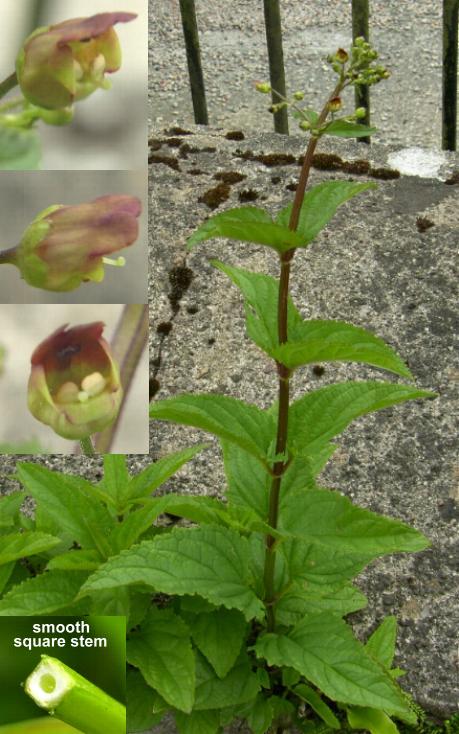|
|
Common Figwort
Scientific Name: Scrophularia nodosa
Other names: Knotted Figwort, Throatwort, Carpenter's Square, Kernelwort
Family: Scrophulariaceae (Figworts)
|
A perennial which prefers damp shady places where it reaches about 60cm in height, but the specimen in this picture was growing out of a crevice on the top of an old stone wall.
The coarsely toothed leaves are in opposing positions up the hairless stem which is square in section. The roots are nodular tubers - giving rise to the species name, nodosa.
Flowering occurs between June and September with open, branched clusters of the two-lipped flowers. The upper lip is brownish-purple and the lower one is green, as is the rest of the structure. They are visited by bees and wasps.
Figwort was an important medicinal herb as it was used to treat the skin lesions resulting from tuberculosis - the genera name Scrophularia relates to Scrofula the medical term for tuberculosis of the lymph glands which caused ulcers, usually on the neck (hence Throatwort). It also has mild purgative properties and is a cardiac stimulant. It is mainly used externally in modern herbal medicine to treat eczema, psoriasis and itching skin with some treatment for mild constipation and as a diuretic. The whole plant is harvested for medicinal use at the time of flowering.
In folk medicine it was highly thought of in Ireland, known as 'the queen of herbs' which derived its special powers by growing under the elder tree, another venerated herb, but would lose power if allowed to touch the ground after it was picked. The boiled liquid from the roots, leaves and sometimes berries was drunk to cleanse the blood. Externally an ointment made with lard was applied to piles, and a leaf could be applied as a poultice to sprains and swellings.
The tuberous roots taste and smell unpleasant so would not normally be chosen to eat. However, during the siege of Rochelle, France, in 1628 they were eaten for survival. The leaves cause purging and vomiting if chewed by grazing cattle, but they normally avoid them.
The tuberous rhizome remains as a clump and is easily uprooted, remove before seed develop.
Weedkillers to use:-
Glyphosate is systemic so is taken down to the roots.
Nicholas Culpepper
(17th century astrologer-physician)
"A better remedy cannot be for the King's-evil, because the Moon that rules the disease is exalted there"
King's-evil - a constitutional condition with glandular swellings and tendency to tuberculosis, scrofula.
Follow these links for further details on Weeds, Weed Removal and Weed
Prevention. |
 |
